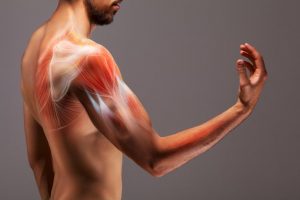Biceps Tenodesis & Tenotomy
If you’ve been experiencing shoulder pain caused by the bicep tendon, you may need biceps tenodesis or tenotomy. This pain could be due to wear-and-tear or inflammation caused by injury, excessive use or aging. Our team of orthopedic surgeons at OrthoBethesda is ready to offer the best orthopedic services to residents of Bethesda, MD, and its surrounding areas. Our specially trained doctors are prepared to help you if you need biceps tenodesis or tenotomy today.

What Are Biceps Tenodesis and Tenotomy?
Biceps tenodesis is a surgical procedure used to repair the tendon that connects the biceps to the shoulder. The biceps have a long head that’s connected to the upper section of the glenoid — shoulder socket. This long head is prone to tears, strains and inflammation.
Biceps tenodesis and biceps tenotomy both involve cutting off the tendons from the cartilage inside the glenoid. The primary difference between the procedures is that in tenodesis, the tendons get reattached to the bone of the upper arm — humerus. In contrast, the tendons are not reattached in tenotomy but allowed to heal onto the humerus for several weeks.
The biceps will still work after a tenotomy, but the procedure could flatten the biceps. For people who do sedentary work, tenotomy may be adequate. However, tenodesis is usually more appropriate for athletes.
What Are the Common Reasons for Biceps Tenodesis and Tenotomy?
Biceps tenotomy and tenodesis relieve the pain caused by injury, inflammation or bicep tendon tears. Any of these procedures may be performed when there’s intense pain from the biceps tendon in the front or topmost section of the shoulder. Such pain may be quite intense at night, and it can affect other parts of the arm. Patients who need this procedure may also experience swelling, tingling, and cramping and have difficulty moving their arms or shoulders.
Biceps Tenodesis and Biceps Tenotomy Procedures
Biceps tenodesis is done with general anesthesia using any of the following techniques:
- The Pitt technique: This is a soft tissue technique in which the doctor creates an interlocking suture pattern and ties the tendon to the shoulder ligament.
- Open keyhole procedure: This is another soft technique in which the surgeon creates a keyhole opening in the humerus. Then, an end of the bicep is rolled up and stitched into place.
Who Should Have Biceps Tenodesis and Tenotomy Surgery?
Anyone who wants total relief from shoulder pain and has an injured biceps tendon should opt for biceps tenodesis. This procedure has helped athletes experience lasting pain relief and more effective use of their arms and shoulders. This surgery is quite effective when it’s performed within three months after the initial injury.
What to Expect During Biceps Tenodesis and Tenotomy Recovery?
For close to six weeks, patients must wear a sling to restrain the movement of their arm and allow the tissues to heal quickly. After six weeks, patients can start to increase their arm’s range of motion. With the help and guidance of a physical therapist, patients can move gradually into strength training. With regular training sessions, patients can start increasing the range of motion and the amount of effort they put on their shoulders, arms, and hands.
Complete recovery usually occurs after about 20 weeks. The precise recovery time will depend on the:
- Type of rehabilitation program
- Patient’s age
- The severity of the injury
- Patient’s health status
Further Reading
Tenodesis vs. Tenotomy
Shoulder Pain – Biceps Tendonitis
Schedule an Appointment
 ">
">
Get in Touch
Contact OrthoBethesda to Discover if Biceps Tenodesis Is the Best Option for You
OrthoBethesda has a team of specially trained and highly skilled orthopedic surgeons who use the most modern and effective tools and techniques to treat shoulder pain. Please take the next step and contact us now by calling (301) 530-1010 to book an appointment with an orthopedic surgeon.
